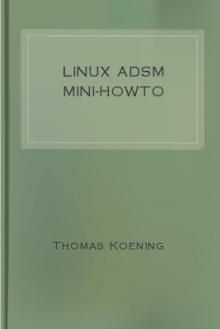Linux ADSM Mini-Howto by Thomas Koening (best books to read for success .TXT) 📕

- Author: Thomas Koening
- Performer: -
Book online «Linux ADSM Mini-Howto by Thomas Koening (best books to read for success .TXT) 📕». Author Thomas Koening
Linux ADSM Mini-Howto
by Thomas Koenig, Thomas.Koenig@ciw.uni-karlsruhe.de
v, 15 January 1997
This document describes how to install and use a client for the commercial ADSM backup system for Linux/i386.
Table of Contents
Introduction
Installing the iBCS module
Installing the ADSM client
Running the client
Known Problems
IntroductionADSM is a network-based backup system, sold by IBM, in use at many
organizations. There are clients for a large variety of systems
(different UNIX brands, Windows, Novell, Mac, Windows NT).
Unfortunately, at the time of this writing, there is no native Linux
version.
You will have to use the SCO binary, and install the iBCS2-emulator
for running ADSM. This description is for ADSM v2r1.
At the time if this writing, I am only aware of a version which works
with the i386 version of Linux.
Installing the iBCS moduleThe iBCS2 module is available from
ftp://tsx-11.mit.edu/pub/linux/BETA/ibcs2. If you are running kernel
version 1.2.13, get ibcs-1.2-950721.tar.gz, unpac it and apply the
patches ibcs-1.2-950808.patch1 and ibcs-1.2-950828.patch2. You can
then type "make" and install the iBCS modlue with "insmod".
For a 2.0 kernel version, get ibcs-2.0-960610.tar.gz, unpack it in a
suitable place, chdir into that directory, and apply the following
patch:
--- iBCSemul/ipc.c.orig Wed Jan 15 21:32:15 1997
+++ iBCSemul/ipc.c Wed Jan 15 21:32:31 1997
@@ -212,7 +212,7 @@
switch (command) { case U_SEMCTL: cmd = ibcs_sem_trans(arg3);arg4 = (union semun *)get_syscall_parameter (regs, 4);
arg4 = (union semun )(((unsigned long ) regs->esp) + (5));
is_p = (struct ibcs_semid_ds *)get_fs_long(arg4->buf); ifdef IBCS_TRACE if ((ibcs_trace & TRACE_API) || ibcs_func_p->trace)Then, copy CONFIG.i386 to CONFIG, and type make.
If you don't have them already, create the needed device files by
executing
cd /dev ln -s null XOR ln -s null X0R mknod socksys c 30 0 mknod spx c 30 1 Installing the ADSM clientThe SCO binary is supplied as three tar files, or disks. Change to
the root directory, set your umask according to your policies, and
unpack them from there (as root). In your Directory /tmp, you will
find an installation script; execute that.
You will then have to hand-edit /usr/adsm/dsm.sys and
/usr/adsm/dsm.opt. In dsm.sys, important lines to specify are:
Servername
The name of the serverTCPServeraddress
The fully qualified host name of the serverNODename
Your own hostnameIn dsm.opt, you will have to specify
Server
As beforeFollowsymbolic
Wether or not to follow symbolic links (not a good idea, in general)SUbdir
Wether to back up subdirectories (you usually want that)domain
The file systems to back upYou will then have to create a SCO-compatible /etc/mnttab from your
/etc/fstab. You can use the following Perl script, fstab2mnttab, for
this.
!/usr/bin/perl$mnttab_struct = "a32 a32 I L";
open(MTAB, "/etc/mtab") || die "Cannot open /etc/mtab: $!n";
open(MNTTAB, ">/etc/mnttab") || die "Cannot open /etc/mnttab: $!n";
while() {
next if /pid/;
chop;
/^(S)s(S)s(S)s.$/;
$device = $1;
$mountpt = $2;
$fstype = $3;
if($fstype ne "nfs" && $fstype ne "proc") {
$mnttab_rec = pack($mnttab_struct, $device, $mountpt, 0x9d2f, time()); syswrite(MNTTAB, $mnttab_rec, 72); print "Made entry for: $device $mountpt $fstypen";}
}
close(MNTTAB);
exit 0;
You do not need to install any shared libraries for these clients;
everything is linked statically.
Running the clientThere are two clients, dsm, which is an X11 interface, and dsmc, a
command-line interface. Your computer centre will tell you how to run
it. Some startup script at boot, for example
dsmc schedule -quiet 2>&1 >/dev/null &
will probably be required.
Known ProblemsUnfortunately, SCO can only deal with hostnames no longer than eight
characters. If your hostname is longer, or fully qualified, you may
need to specify your hostname on the NODename line in
/usr/adsm/dsm.sys.
If you use the DISPLAY variable, you will have to supply the fully
qualified host name (i.e. DISPLAY=host.full.do.main:0 instead of
DISPLAY=host:0).





Comments (0)